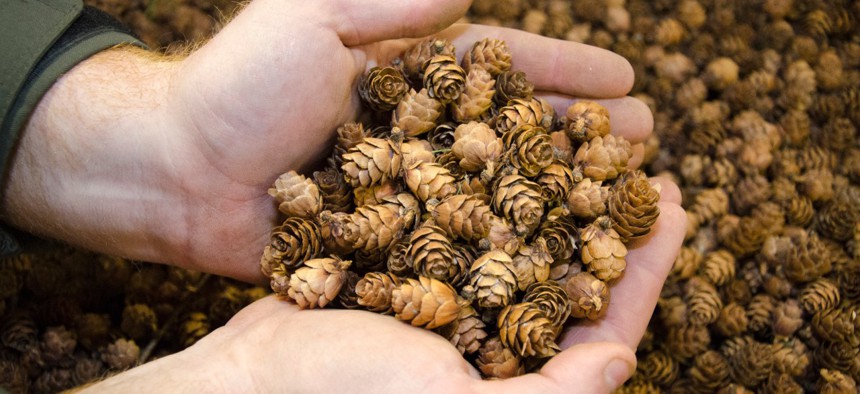How Residents Help Replenish One State's Seed Stores

Tamarack cones are among the smallest and the most difficult to harvest. Minnesota Department of Natural Resources

Connecting state and local government leaders
Minnesota recruits "private pickers" to harvest cones and seeds for reforestation projects by paying by the bushel.
Every year at the tail end of summer, dozens of citizens fan out through the Minnesota wilderness, collecting cones and seeds for the state Department of Natural Resources.
The "private pickers," as they’re called, get money for each bushel of cones they collect, while the DNR replenishes the seed stock at the state nursery without having to send staff members into the woods. The program has been in place for years, but some pickers are beginning to age out of the job, and the state foresees a shortage in the future.
“We don’t have as many experienced folks out there able to collect in large quantities. We’re getting smaller quantities, which means we need to work with new people,” said Kristina Somes, the state’s nursery supervisor. “We’re in a transition phase. We’re not in panic mode, but we’re projecting that in the coming years it’s going to be more difficult to find folks interested and willing to do it.”
A shortage could have tangible effects. Private pickers are the primary method by which the agency replenishes its seed stores at the nursery, a 150-acre facility that grows between 3 and 6 million seedlings—primarily conifers—each year. More than half of those plants go to reforestation projects, and when possible, DNR officials try to replant seedlings in the same area where the seeds were originally recovered.
.jpg)
To accomplish that goal, the agency divides the state into six seed-collection zones, then sets individual quotas for each species within every zone. Officials aim to have a five-year supply of each species from each area, which allows targeted replantings with seedlings that are most likely to survive the variations in climate from place to place.
“So rather than us collecting seed at the Lake of the Woods, which is the farthest north you can go in Minnesota, and sending those seedlings south to the border of Iowa, we try to make sure that our southern seed stock goes back to the south,” Somes said. “To cover seed and cone collection throughout the state is a pretty big task.”
Doing it well requires a comprehensive statewide network of pickers, who collect acorns but primarily focus on cones, including pinecones, spruce cones and fir cones. A cone’s primary function is to keep a tree’s seeds safe from wind, cold temperatures and animals. Cones open when the seeds are mature and conditions are right for their dispersal; typically, during warm, dry weather.
Volunteers don’t have to know the different species when they sign up, but those who don’t must be willing to work with forestry officials to learn the differences between, for example, an unripe cone (typically yellow or green in color) and one that’s ready to be picked (brown or purple), but isn’t too ripe for collection (once a cone begins to open, the seeds fall out and it can't be used for planting). To ensure quality, foresters check each load that’s brought in; usable cones and seeds can fetch anywhere from $20 to $150 per bushel.
“White-pine cones are the largest cones and they’re basically the easiest to collect and fill up a bag of, but they’re also the cheapest,” Somes said. “You can get up to $150 per bushel for tamarack, because they’re such small cones and they’re much more difficult to collect.”
Only the most experienced pickers are entrusted with harvesting from tamarack trees, and it’s one of few species that DNR officials will pick themselves. That's because the small cones grow mostly near the top of the tree, making them difficult to pick. It’s also the only species that’s ripe at the moment, and until “easier” kinds are ready to be harvested, Somes won’t know how many pickers she’ll have this year. She’s hoping for around 165, roughly the same number as last year.
“What I’m looking for is having just a robust amount of pickers in each of our zones so we can get the seed diversity we’re looking for,” she said. “What’ll happen sometimes is we might get a whole bunch of cones from one area, but we don’t have any pickers in another area, so we have to send seeds from an adjacent area instead—which is OK, but not as good as sending a seedling back we know is well adapted to that zone. So if we have a robust community throughout the state, that’s really ideal.”
Kate Elizabeth Queram is a Staff Correspondent for Route Fifty and is based in Washington, D.C.

NEXT STORY: Vaping Craze Prompts New State Taxes




